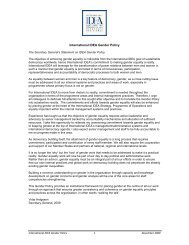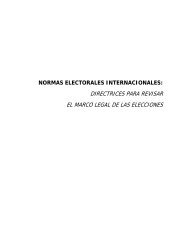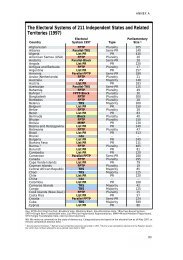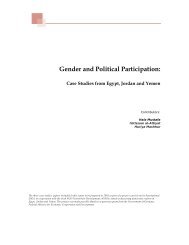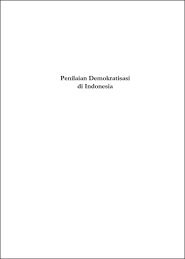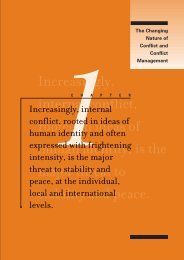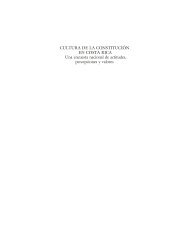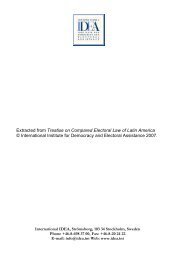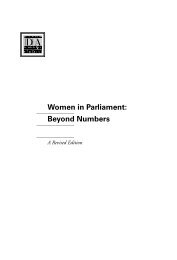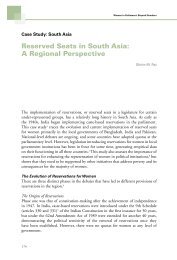The Role of State Constitutions in Protecting ... - International IDEA
The Role of State Constitutions in Protecting ... - International IDEA
The Role of State Constitutions in Protecting ... - International IDEA
You also want an ePaper? Increase the reach of your titles
YUMPU automatically turns print PDFs into web optimized ePapers that Google loves.
<strong>The</strong> situation began to change <strong>in</strong> the latter 20th century, as world op<strong>in</strong>ion changed.<br />
In 1967, the Constitution was changed to give the Commonwealth<br />
concurrent power <strong>in</strong> relation to <strong>in</strong>digenous people. In the 1970s the<br />
Commonwealth began to implement land rights legislation, although only <strong>in</strong> the<br />
Northern Territory, where it had more complete legislative power. In South<br />
Australia, also, some public lands were given to <strong>in</strong>digenous people; but <strong>in</strong> general<br />
the <strong>State</strong>s resisted the land rights movement at this stage. In 1992, <strong>in</strong> the<br />
landmark decision <strong>in</strong> Mabo v Queensland (No.2) the High Court <strong>of</strong> Australia held<br />
that the common law <strong>of</strong> Australia would, after all, recognise <strong>in</strong>digenous title to<br />
land, if it could be proved and if it had not been subsequently overridden by, for<br />
example, the general land law. While the Mabo criteria were difficult for<br />
<strong>in</strong>digenous groups to meet, it was a symbolically important decision. <strong>The</strong><br />
Commonwealth enacted legislation to control the claims process. <strong>The</strong> <strong>State</strong>s were<br />
unable to nullify the effect <strong>of</strong> the Mabo decision, because <strong>of</strong> superven<strong>in</strong>g<br />
Commonwealth law. <strong>The</strong> greater barga<strong>in</strong><strong>in</strong>g power <strong>of</strong> the <strong>in</strong>digenous people led<br />
to some greater will<strong>in</strong>gness to negotiate with them, on the part <strong>of</strong> <strong>State</strong>s and<br />
private sector <strong>in</strong>terests. By the end <strong>of</strong> the 20th century, there were some<br />
specifically <strong>in</strong>digenous local government areas, with<strong>in</strong> <strong>State</strong>s and territories and<br />
other areas where <strong>in</strong>digenous people pursued their own culture, on their own<br />
lands.<br />
…m<strong>in</strong>orities, especially<br />
small m<strong>in</strong>orities, need<br />
protection from majorities<br />
that are likely to be hostile or<br />
<strong>in</strong>different to their <strong>in</strong>terests.<br />
…the protection needs to be<br />
provided by both national<br />
and <strong>State</strong> <strong>Constitutions</strong>.<br />
In the scheme <strong>of</strong> th<strong>in</strong>gs, these changes were important, but m<strong>in</strong>or. Indigenous<br />
Australians are still struggl<strong>in</strong>g for land, equal economic opportunity and<br />
recognition <strong>of</strong> their law and culture. Nevertheless, their new barga<strong>in</strong><strong>in</strong>g power,<br />
however small, may enable them to make the federal system work better for them.<br />
Federal systems <strong>in</strong>volve different governments, with different ideologies and<br />
policy preferences. In pr<strong>in</strong>ciple, they <strong>of</strong>fer the opportunity for experimentation;<br />
and successful experiments tend to spread. Thus more <strong>State</strong>s are consider<strong>in</strong>g the<br />
return <strong>of</strong> lands to <strong>in</strong>digenous people; some <strong>State</strong>s are experiment<strong>in</strong>g with<br />
<strong>in</strong>digenous court systems; some are enter<strong>in</strong>g <strong>in</strong>to agreements with <strong>in</strong>digenous<br />
people, to provide a greater measure <strong>of</strong> self-government and economic<br />
development. It is easier for <strong>in</strong>digenous people to achieve representation <strong>in</strong> the<br />
relatively smaller <strong>State</strong> or territory Parliaments, although there is presently one<br />
<strong>in</strong>digenous Senator <strong>in</strong> the national Parliament as well. It is possible that one or<br />
more <strong>State</strong> <strong>Constitutions</strong> might eventually recognise the <strong>in</strong>digenous people and<br />
provide some protection for their <strong>in</strong>terests. In particular, if and when the<br />
Northern Territory becomes a <strong>State</strong>, there will certa<strong>in</strong>ly be pressure for<br />
acknowledgement <strong>of</strong> <strong>in</strong>digenous law and culture <strong>in</strong> the Constitution <strong>of</strong> a <strong>State</strong> <strong>in</strong><br />
which <strong>in</strong>digenous people constitute 25% <strong>of</strong> the population.<br />
In general, however, this aspect <strong>of</strong> the Australian experience throws up negative<br />
lessons. It shows that m<strong>in</strong>orities, especially small m<strong>in</strong>orities, need protection from<br />
majorities that are likely to be hostile or <strong>in</strong>different to their <strong>in</strong>terests. It shows that<br />
the protection needs to be provided by both national and <strong>State</strong> <strong>Constitutions</strong>.<br />
And while protection <strong>of</strong> political, economic and cultural rights is necessary, the<br />
Australian experience suggests that it is not sufficient. Treatment <strong>of</strong> m<strong>in</strong>orities <strong>in</strong><br />
41




